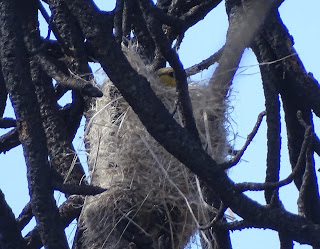Despite a snowy winter, the San Jacinto Mountains like most places in the west are once again in drought conditions. With little rainfall this year, there are fewer blooming flowers. So what do you do if you are a nectaring insect? Search for a blooming patch!
Coronis Fritillary
With fewer food and nectar plants available, there are fewer caterpillars and adult butterflies. While the birds are keeping a low profile since they are busy feeding and protecting chicks, I have been looking for other signs of life. I have no trouble finding lizards these days but I've seen very few butterflies. The other day I finally spotted a variety of winged beauties when I found a patch of purple flowers - mustang mint and southern mountain wooly stars.
Monarch
While I was trying to get photos of other butterflies, this monarch surprised me with a brief landing.
This is one of the few sightings of monarchs that I have seen this season despite all of the healthy milkweed plants that are growing.
Joba Skipper
The wooly star flower was the magnet for the majority of butterflies that I found on this trail.
Although the butterfly population seems lower than normal, the bees seem to be doing pretty well. When I saw this insect, I thought it was a bee until I started watching it carefully.
The first noticeable difference is that this "bee" didn't land on the flowers. Rather, it hovered in place and flew from one flower to another like a "hummingbird".
Then I noticed that it had a proboscis for slurping up nectar. Definitely not a bee! So what is this hummingbird/bee insect?? It is officially called a Snowberry clearwing moth (Hemaris diffinis) but it's nickname is "Hummingbird Moth". Watching this moth and trying to figure out what it was mesmerized me. Because I stood here so long trying to get a decent photo of this moth in constant motion, a well-meaning passerby asked if I was okay. ha
Hedgerow Hairstreak
My morning of unexpected "butterflying" ended with this hairstreak. Did you know they have hairlike projections off of their hindwings to trick predators into going after them instead of their head/antennae area to live another day?
My latest unsolved mystery is why this beautiful unidentified dragonfly returns to our yard and lands on this pipe.....If you know the answer or know the ID of this beauty, let me know!
A special thanks to Bruce, our local expert, for the butterfly identification.
Click on photos to enlarge.
Photos and content by Robin Roberts.















